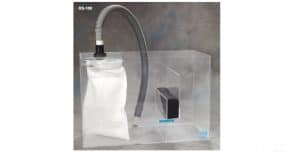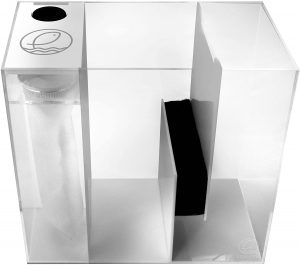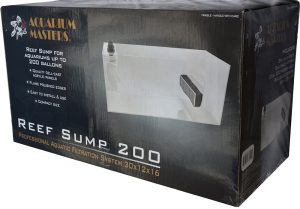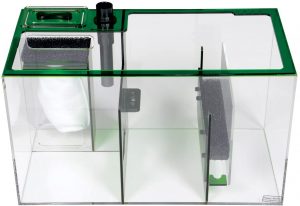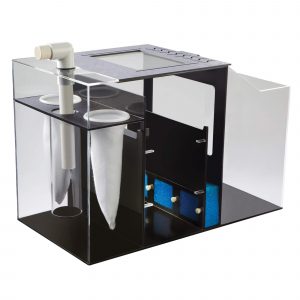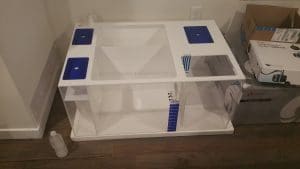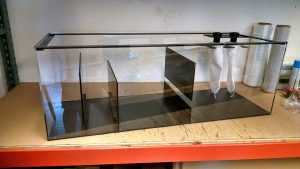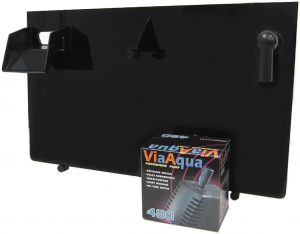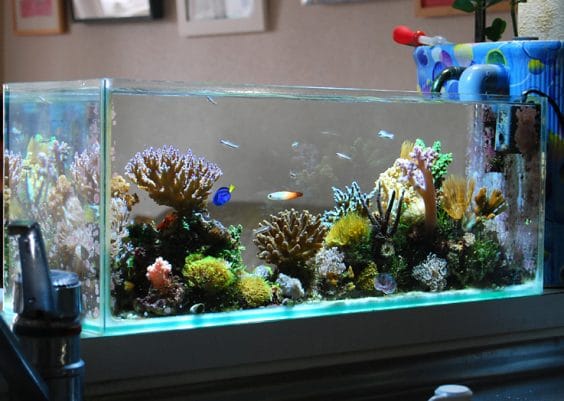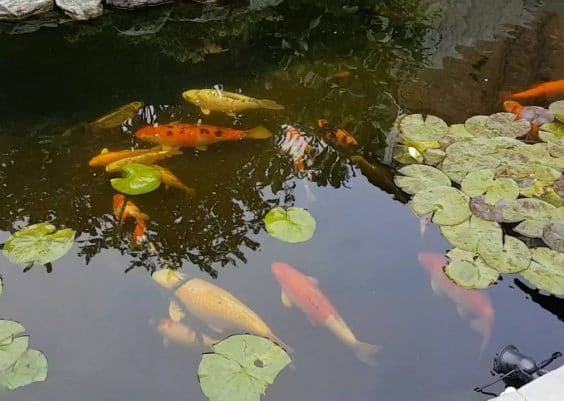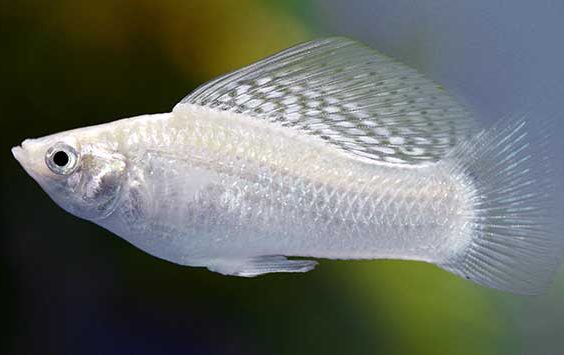Contents
- Quick Comparison of the best Aquarium Sumps and Refugiums
- Top 10 Best Aquarium Sumps and Refugiums Reviews
- 1. Eshopps AEo14005 Reef Sumps
- 2. Eshopps Wet Dry Sump Filter
- 3. Esh Sump Reef System Rs-75
- 4. Aquarium Masters 200 Gallon Reef Sump
- 5. Trigger Systems 4431 Emerald Sump
- 6. Aqueon ProFlex Sump
- 7. IceCap 48XL Reef Sump
- 8. Windridercreations Sump Kit
- 9. CPR AquaFuge2 Hang-On Refugium
- 10. Eshopps AEO15005 Refugium
- What is a Sump?
- Wet-dry and Trickle Filters
- The Berlin Method
- Aquarium Automation
- Protein Skimmers and Filter Sumps
- DC Return Pumps
- What is a Refugium?
- Final Thoughts
Aquarium sumps and refugiums are significant additions to any fish tank, especially if you have a large one.
These give you plenty of surface space to hide other equipment, allowing you to customize your filtration to your liking and create a safe space for your plants or fish.
The following article will provide you with details on aquarium sumps and refugium, plus naming some of the best options for your tank.
Quick Comparison of the best Aquarium Sumps and Refugiums
| # | Product Name | Image | Price | Action |
|---|---|---|---|---|
| 1 | Eshopps AEo14005 Reef Sumps |
| $$ | Buy on Amazon! |
| 2 | Eshopps Wet Dry Sump Filter |
| $$ | Buy on Amazon! |
| 3 | Esh Sump Reef System Rs-75 |
| $$ | Buy on Amazon! |
| 4 | Aquarium Masters 200 Gallon Reef Sump |
| $$ | Buy on Amazon! |
| 5 | Trigger Systems 4431 Emerald Sump |
| $$ | Buy on Amazon! |
| 6 | Aqueon ProFlex Sump |
| $$ | Buy on Amazon! |
| 7 | IceCap 48XL Reef Sump |
| $$$ | Buy on Amazon! |
| 8 | Windridercreations Sump Kit |
| $$ | Buy on Amazon! |
| 9 | CPR AquaFuge2 Hang-On Refugium |
| $ | Buy on Amazon! |
| 10 | Eshopps AEO15005 Refugium |
| $$ | Buy on Amazon! |
Top 10 Best Aquarium Sumps and Refugiums Reviews
1. Eshopps AEo14005 Reef Sumps

This aquarium sump includes a clean in-line design that helps your tank maintain its aesthetic look. The model is perfect for tanks up to 100 gallons in size and also works for any smaller aquarium too.
The most noticeable feature is that the sump provides a micron bag to sort out floating debris. There’s also an air diffusion capability that decreases the noise significantly.
Besides, the Eshopps sump has enough space to place a protein skimmer, and it can be used as a wet or dry filtration system. Moreover, it consists of a sponge to further decrease microbubbles and support the growth of beneficial bacteria.
Pros
- Can be set up as a wet/ dry filter or a refugium
- Include a sponge to diffuse bubbles and facilitate bacteria growth
- Quiet operation
- Good flow rate
Cons
- Hook-ups are difficult to get to once installed.
- Included hoses are quite long
2. Eshopps Wet Dry Sump Filter
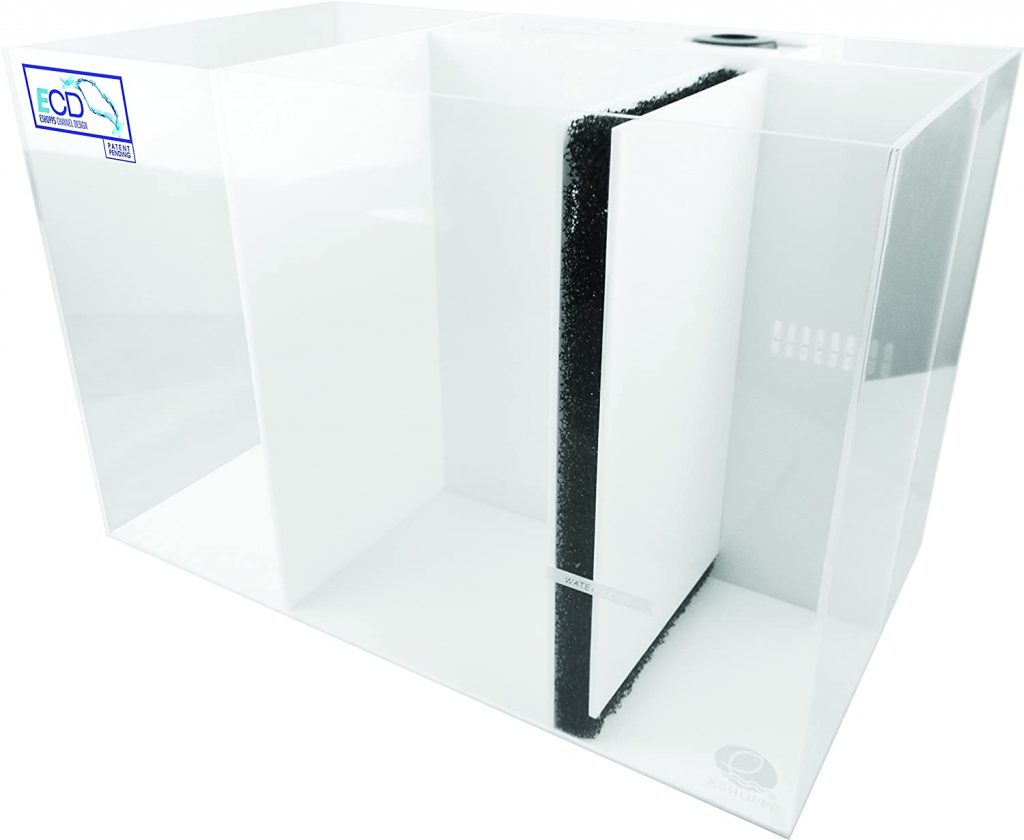
The Eshopps sump model is an incredible choice to start for those who are new to the world of aquarium sumps. The sump is available in an array of sizes to fit tanks with various capacities from 10 to 300 gallons. You can select a model with either a dual or single intake.
This aquarium sump belongs to a popular brand that sits within the mid-range price. Thanks to its decent design, it can fit into your aquarium cabinet without taking up too much space.
In spite of the product’s compact dimensions, the sump still provides a large bio-ball capacity. The sump filter offers excellent biological filtration and comes equipped with an overflow box, drip tray, and cover.
In addition, you’ll get a filter pad and egg crate with the sump kit. The model is constructed from high-grade acrylic, making it sturdy and suitable for both freshwater and saltwater tanks.
Pros
- Smart, simple to access the pump
- Provide a built-in refugium and overflow box
- Large bio-ball capacity
Cons
- The installation should be clearer for new users to understand.
3. Esh Sump Reef System Rs-75
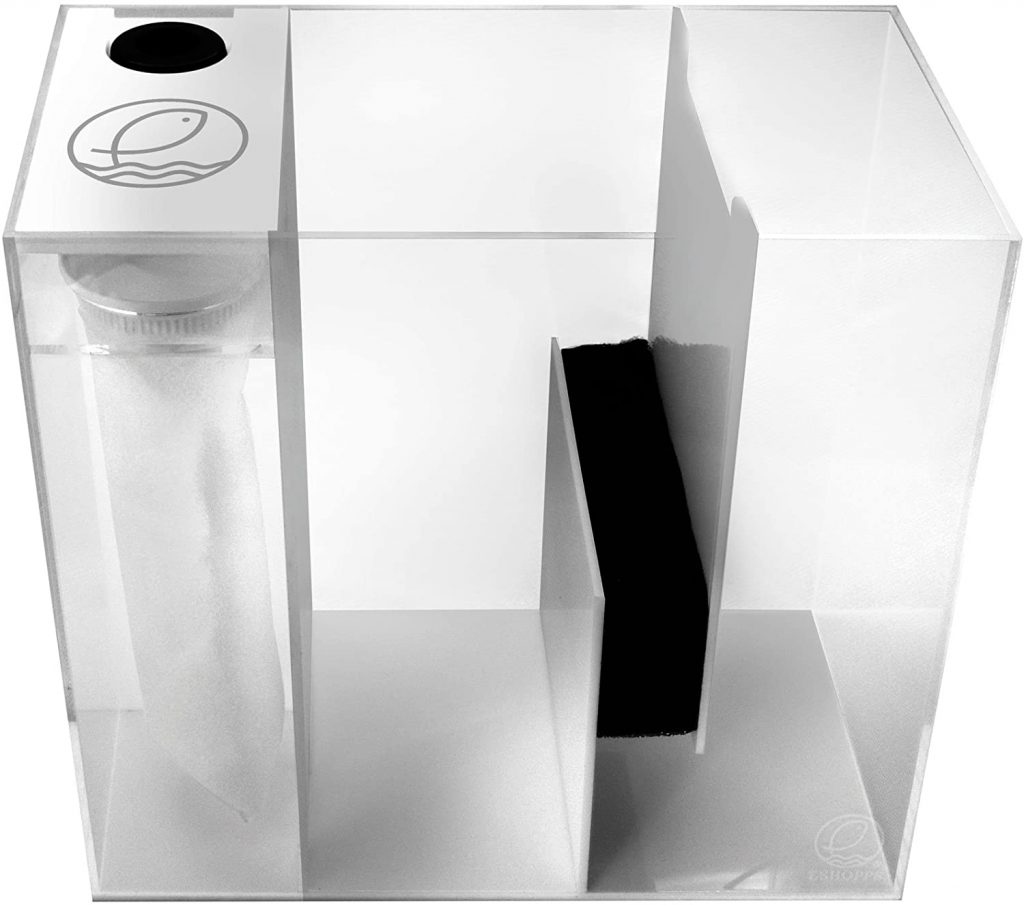
The Esh Sump Reef System is specifically created for those seeking a way of leveraging their saltwater tank without the usual intrusion of filtration devices that spoil the look of the aquarium.
This aquarium sump is suggested for use with a 10 to 75 gallons of marine reef system, even though you can also use it for a tropical freshwater setup.
The sump stays underneath the main display tank and acts as a filter, as well as a holding place for protein skimmers, heaters, calcium reactors, etc. The compact model will suit aquarium cabinets that are 18 x 10 x 16 inches or bigger.
The sump is constructed from thick, premium, crystal-clear glass, which can accommodate a refugium, a small return pump, and a sterilizer unit.
Pros
- Reasonable price
- Fit most cabinets
- Superb quality and well-made
- Quiet operation
Cons
- The return area is a bit large.
4. Aquarium Masters 200 Gallon Reef Sump
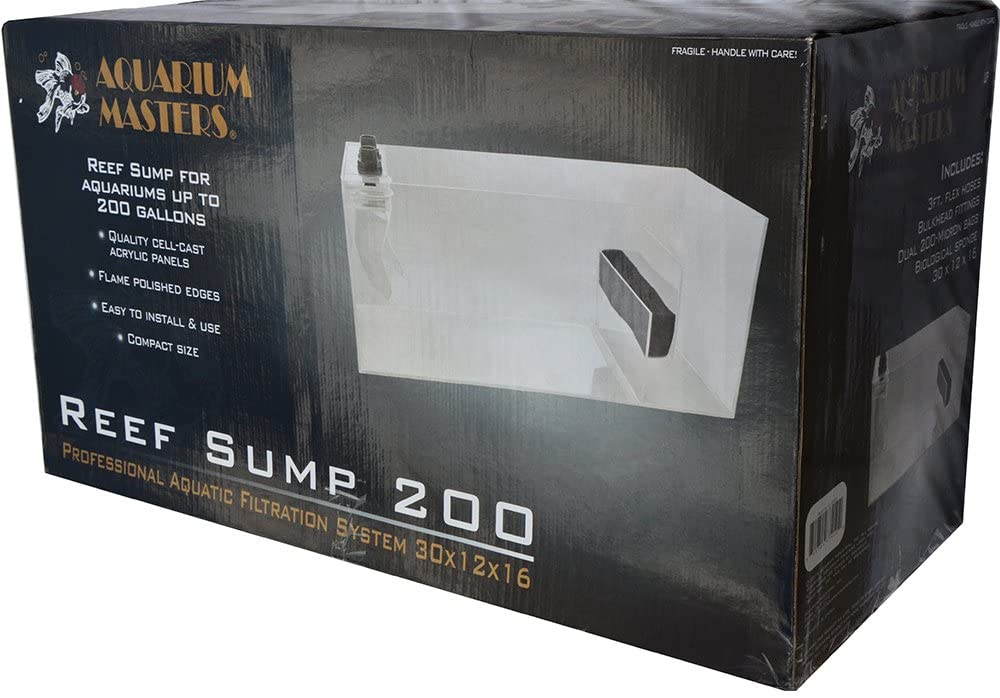
The sump from Aquarium Masters is built for use with marine, coral frag tanks with a capacity of up t0 200 gallons.
This aquarium sump is well-constructed and comes with quality cell-cast acrylic panels with flame-polished edges, making the unit extremely sturdy and durable.
The sump is compact, not taking up much space in your cabinet. You will get detailed instructions to install and set up the sump with ease.
Pros
- Compace, space-savign size
- Simple to install and use
- Affordable price
Cons
- Can only be used in marine tanks
- Only proper for use with medium-sized aquariums up to 200 gallons
5. Trigger Systems 4431 Emerald Sump

Trigger Systems is a famous US-based manufacturer of filter sumps, automatic top-offs (ATOs) and dosing systems.
The acrylic aquarium sump is hand-assembled with high-quality acrylic and precision welding methods. In addition to the Emerald color, there are other options such as Ruby, Sapphire, Crystal, and Amethyst), all looking amazing underneath the reef tank.
The sump comes with adjustable baffles, making it simple for the sump to double as a refugium. The water height in the skimmer section can be modified. Users can leverage filter socks and filter foam blocks for particulate elimination.
Markedly, the Trigger Systems sumps are pre-drilled for including an automatic top-off system. They come in a variety of sizes, from the small 18-inch cube to the monster Triton 44-inch sump.
Pros
- Brilliant craftmanship
- Available in different sizes and colors
- Quiet operation
- The modular design makes customization easier.
Cons
- Quite pricey
6. Aqueon ProFlex Sump

This Aqueon ProFlex three-chambered sump is modular, so you can flexibly customize the setup in various ways.
The basic sump design contains two 200-micron filter socks in the initial chamber of the sump.
Incoming water flows through the socks for particulate removal. The modular design enables you to set up an optional wet-dry biological rack that holds plastic biomedia. You will need to buy the rack as an additional component and supply your own biomedia.
For a Berlin-style filter, add an internal protein skimmer to the second sump chamber and return the pump in the last. It’s simple to install a refugium in the last chamber. You just need to add macroalgae and rock rubble along with a small LED light fixture.
Pros
- Quiet operation when working as a berlin or refugium
- Filter socks offer excellent particulate filtration
- Work well as a refugium when light is included
Cons
- Poor packaging might lead to damaged panels and higher return rates.
7. IceCap 48XL Reef Sump
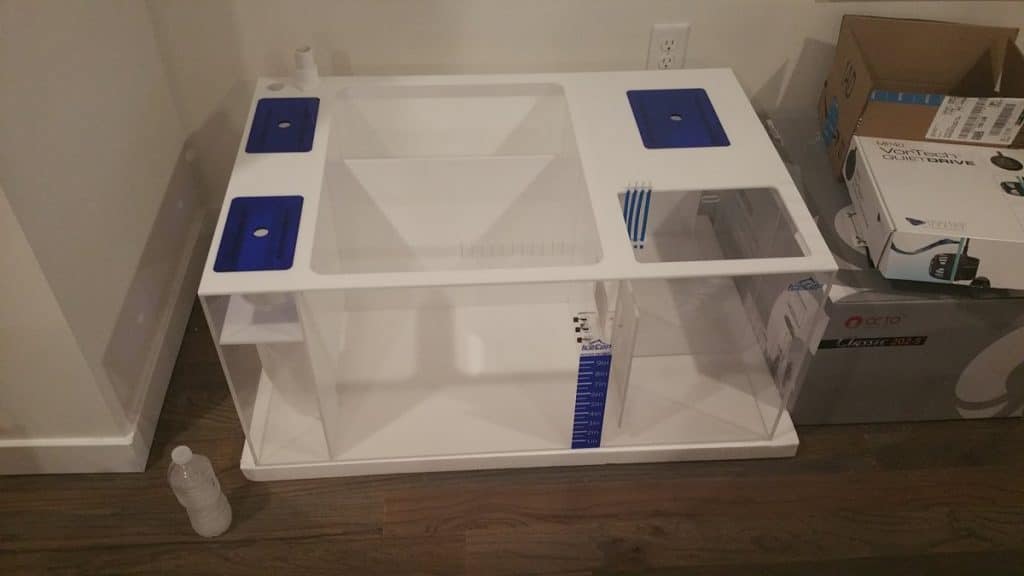
The IceCap aquarium sump is designed for modern-day reef tanks. It is created to satisfy all your requirements and measures 48 x 23.5 x 16 inches. It is suggested for 300-gallon tanks, but it can fit aquariums up to 350 gallons.
It comes equipped with a dual one-inch drain and dual four-inch filter sock holders. The freshwater reservoir is able to contain 15 gallons of water. Plus, it provides a skimmer section that measures 24 x 14.8 inches.
In addition, the modern-day sump has a spill-over design and compartment lids. There are also adjustable baffles and probe holders to modify to your filtration needs.
Pros
- Include dual drains
- Include a freshwater reservoir
- Clean and professional looking
Cons
- A refugium section is available in XL models only.
8. Windridercreations Sump Kit

Windridercreations is a renowned aquarium and stand company. They also create and produce acrylic filter sumps and refugiums. The hand-crafted sumps are constructed from 0.25-inch thick acrylic.
The sumps come available as a comprehensive, ready-to-run unit or in DIY kit form. This 50-gallon sump is completely assembled and provides two filter socks. Besides, there are two bulkhead fittings included for connection to your overflow.
The large 20-inch water input chamber is tailored to contain the socks and a large protein skimmer. The second chamber has much room for a refugium, rock, and algae. The return chamber has enough space for most return water pumps.
This filter sump-refugium is highly recommended for fish tanks under 200 gallons. If you want to make it yourself, the filter kit provides pre-cut panels. You can glue the pieces together to create a 30 x 12 x 15-inch sump and refugium.
However, the DIY kit doesn’t come with filter socks or inlet hardware. If you’re confident about setting up your filter sump, you can include your own inlets and filter socks.
Pros
- Hand-cut and fitted
- Reliable build-quality
- Different custom sizes
- DIY option
Cons
- Limited in-stock sizes
9. CPR AquaFuge2 Hang-On Refugium

If you’re searching for a simple HOB refugium or can’t fit one under your aquarium, the AquaFuge 2 deserves your consideration.
This aquarium refugium is packed with a secluded safe zone for live foods such as amphipods and copepods to feed LPS and SPS corals with fish in the aquarium.
The optional LED light will enable you to nurture macroalgae inside the hang-on fuge. The internal baffle system helps save sand and live foods from being cleared out of the chamber.
Moreover, the AquaFuge aquarium refugium consists of a Rio submersible pump, making it a plug-and-play setup.
Pros
- Decent HOB design
- Include a water pump
- Multiple units can be used on large tanks.
Cons
- Not fit a tank with a fitted hood
10. Eshopps AEO15005 Refugium
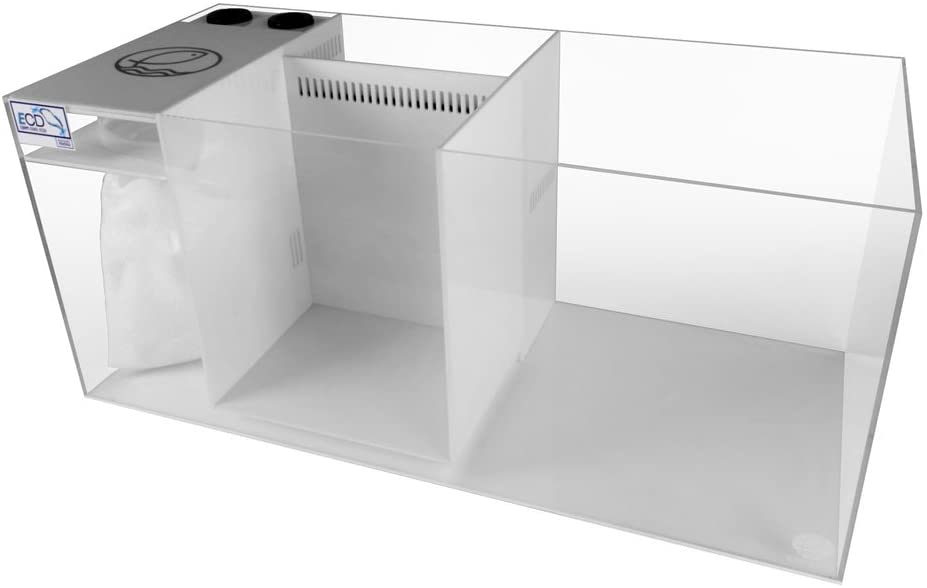
The Eshopps refugium is an incredible aquarium refugium, suitable for tank owners who want to keep the aesthetics of their display aquarium.
This unit is a miniature ecosystem that can be used for placing all your aquarium equipment, storing sensitive creatures or plants, or simply boosting the water volume of your tank.
The model is constructed from acrylic and foam, making the equipment lightweight and portable while making sure its strength and durability.
The filter and stoppages are already built-in, and the operation is super quiet, so you won’t be bothered while watching TV or working.
This aquarium refugium is ideal for tanks up to 100 gallons capacity and has a lot of space for extra pieces of equipment.
Pros
- Reliable and top-grade quality
- Used for aquariums up to 100 gallons in capacity
- Provide micron bags
- Have room for additional tank equipment
Cons
- Accessing the return pump might be tricky.
What is a Sump?
A sump is an additional tank where you can add filters, protein skimmers, pumps, and other cleaning devices without getting them in the aquarium.
It is similar to a tank where you place all of the essentials to save space in your main tank.
An aquarium sump often includes three sections:
- The drain section
- The flex space section
- The return section
The drain section will often contain mechanical filtration through filter cups or filter rocks that will have floss or sponges with chemical media. In most saltwater setups, this is the place where you put a protein skimmer.
A flex space section is a place where a refugium will be spaced. Sometimes live or dry rock is added with macroalgae to facilitate microfauna and to eliminate excessive nitrates and phosphates from the tank. In a freshwater tank, users can use this section as a safe place to keep freshwater plants like Guppy Grass, Duck Weed, Java Fern, Java Moss, Anubias, and Luffy Marimo Moss Balls.
In reef aquariums, there is a new method – Triton Method that changes the order of the refugium and protein skimmer. The refugium is put first, then the skimmer follows it.
The last section is the return section where your return pump goes and where your automatic top-off is placed. The return section is part of the sump that has a variable water level. When your water evaporates the water in the return section will decrease.
Wet-dry and Trickle Filters
Made of transparent acrylic, the sump was placed underneath the tank. It is shaped like a rectangular box that could hold 10 gallons of water or more.
On top of the sump, there was a one-cubic foot acrylic box that contained plastic biological filtration media. The media stayed above the water.
A water pump in the aquarium sump would bring water up into the tank.
As the water level in the tank rose up to the proper height, it flowed into an internal water overflow system, often called a “skimmer box“, and flowed down to the filter sump,
The incoming water spread onto the bio media and trickled into the sump.
The concept was derived from industrial wastewater plants where very high concentrations of contaminants were biologically treated.
The wet-dry or trickle component was created to expose the bacteria living on the bio media to a lot of oxygen, optimizing the elimination of ammonia and nitrite.
It sounded to be a great idea and looked amazing under a reef tank.
Aquarium specialists and retailers told people that a wet-dry filter was essential to handle the ammonia and nitrite released in a reef aquarium.
Reef hobbyists spent more time observing the trickling water than their corals.
However, aquarists who had to bypass the wet-dry filter because of a break-down, lack of parts, or healthy curiosity, found out that the wet-dry filter was unnecessary. The high surface area on live rock offered much space for beneficial bacteria to bloom.
There was no need for a “super-charged” wet-dry filter on reef tanks. Aquarists began getting rid of the biofilter section from the sump and found their corals to grow.
There were no ammonia problems and in some cases, nitrate levels decreased, due to the more efficient in-tank biological filtration.
The wet-dry filter became faded from the hobby, but filter sumps never disappeared. They have become more common than ever. Below’s what occurred next.
The Berlin Method
Reef aquarists were pleased to remove the high evaporation, noisy splashing, and messy salt creep combined with wet-dry filters. However, they really loved the idea of a filter sump.
The modified wet-dry biological filters were gradually known as filter sumps. Aquarists loved the idea of getting the additional room outside of the tank, for topping off and hiding the heater.
Most aquarium sumps included internal baffles, making it simple to add a filter sponge to hold bags of activated carbon, particulates, and other specialty media.
German aquarists conducted more research and included external protein skimming as the main filtration component. This was called The Berlin Method.
Gradually, the filter sump became the center to link external devices such as large protein skimmers and media reactors. The open sump helped plump all the new, high-tech hardware into the tank, without running different hoses up and down the tank’s back. However, the sump story doesn’t end like that.
Aquarium Automation
Today’s automatic aquarium equipment with remote tracking and control via smart devices is widespread. However, long before Wi-Fi appeared, DIY electrical engineers were testing electronic sensing of water levels.
An aquarium sump will ensure the water level in the tank remains the same. However, the water level in the sump declines because of evaporation. If the water is too low, the return pump will begin sucking air and possibly burn out.
A lot of aquarists had enabled the water to evaporate and experienced over-heated pump motors and damaged impellers. By mounting a water level sensor inside the sump, it was possible to include top-off water by using a small dosing pump automatically.
The initial models were heavy and finicky as they were pieced together with industrial components. Nevertheless, we have refined, purpose-built water sensors and automatic top-offs (ATOs) specifically created for filter sumps.
We will continue exploring the sump revolution below.
Protein Skimmers and Filter Sumps
A protein skimmer is regarded as a necessity for keeping water quality in a reef tank.
Elimination of dissolved organics before they break down into phosphate and nitrate goes a long way to enhance the water quality and growth of SPS and LPS corals.
If you wanted a protein skimmer, it needed positioning near the tank. It was a complex install as the skimmers were tall, required a separate water pump and adjustment to keep them working well.
However, with the popularity of filter sumps, protein skimmer producers started designing shorter skimmers to fit the sump.
Nowadays, skimmers get built-in DC-powered water pumps that are compact and effective. Besides, the motors are impeccably matched to the skimmer. You just need to drop the skimmer into the sump.
If you have a filter sump and in-sump protein skimmer, you don’t have to spend hours tweaking and modifying to dial in the skimmer.
DC Return Pumps
In the early days of reef-raising, we needed to use water pumps that weren’t aimed for aquarium use. The majority of pumps were scaled-down industrial models.
They utilized a great amount of electricity and released a lot of heat, sometimes impacting the aquarium’s water temperature.
External water pumps were usually noisy as their motors were created for producing and construction applications.
Today we have got purpose-built “return pumps” invented for tank use. They are smaller, quieter, and more energy-saving.
Users can take control over the DC current motors with a wired controller or via a wireless smart device. The benefit is you can decrease the flow by slowing the motor.
Traditional water pumps are easy to be “choked down” with a valve, making the motor try to push water via the obstruction. Meanwhile, DC water pumps allow you to set up the water flow to stop as you feed your fish and corals.
What is a Refugium?
A refugium is a section in your sump that is considered a safe place for macroalgae and microfauna in saltwater setups. There are some benefits of using a refugium, including:
In a saltwater tank, this helps you cultivate beneficial pods that your fish and corals will consume. The pods also work as a clean-up crew that eats detritus in the tank.
You can use macroalgae and live or dry rock in an aquarium refugium to store pods and sort out excessive phosphates and nitrates in the tank.
In freshwater aquariums, plants can be used as a filtration device to get rid of chemicals and excessive nitrates and phosphates.
Final Thoughts
Every aquarist wants to buy a proven sump design that works without implementing any modifications. Luckily, all those aquarium sumps and refugiums address these criteria.
The Eshopps filter sumps have basic designs with no fancy additionals.
Trigger Systems bring premium aquarium sump and refugium units that are stunning and functional. They’re popular with reef aquarists who establish their tanks to have automatic top-offs and other automation sensors.
Meanwhile, the CPR AquaFuge 2 is a good choice if you just need a refugium. Simple and efficient are the trademarks of this HOB refugium model.
The most useful advice for picking an aquarium sump or refugium is to consider the specifications to ensure it will fit into the tank stand. Then find the chamber dimensions to check whether your return pump and nano protein skimmer will stay comfortably inside.
Some manufacturers produce a large range of add-ons to drop into their sumps. Then consider what features are available for the sump units that fit. Several designs are bare-bones, while others have optional extras that make reef-keeping simpler.


